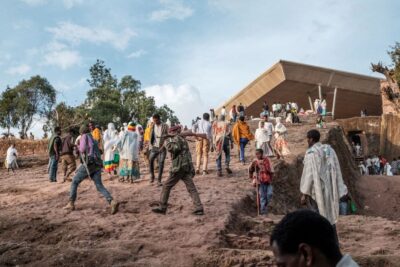“Armed robbers scaled the wall fence around my house in New Government Reserved Area at night. A neighbor who heard some suspicious noise alerted the Police. The Police arrived at my house but could not gain access into my compound because of the high fence and gate. My family and I remained trapped on the inside with the robbers while the Police made frantic efforts on the outside to arrest the situation. The robbers made away with cash and other valuable items.”1Resident of New Government Reserved Area, Makurdi, interview with author, 2015.
“While I was walking along a quiet and deserted street during the day in Lobi quarters, I was accosted by two men on a motorbike. One of them pointed a gun at me and demanded for my mobile phone and cash. I gave them the items and they rode away.”2Resident of Lobi Quarters, Makurdi, interview with author, 2015.
These narratives of residents’ experiences of crime in different residential neighborhoods in Makurdi depict how certain aspects and conditions of the built environment can create opportunities for victimization and hinder formal and informal policing. While governments channel resources to crime prevention through law enforcement agencies, little or no attention is given to social and situational crime prevention. Situational crime prevention targets the physical characteristics of a place that increase the opportunities for crime. However, these physical characteristics do not work in isolation, as residents’ attitudes, behavior, and routine activities also have the potential to contribute to the defensibility of space. For instance, areas with single land-use types like residential areas may be susceptible to crime during the day, especially where the residents work away from home. This is because such residential environments are deserted and unguarded during work hours. This is not to say that mixed land uses are a panacea to crime. Ultimately, what works depends on the context and the interactions between the people and the built environment reflected in how they use, perceive, and act to protect spaces. Areas of criminal high risk and differential vulnerability to risks can be determined by a combination of socioeconomic conditions, demographic characteristics, and the spatial configuration of the urban environment. Here, I argue that both the social and physical characteristics of residents and their environment are important in understanding the distribution of crime and victimization in cities through an exploratory study of these relationships in Makurdi, Nigeria.
Makurdi: Growth and development
During British colonial rule in Nigeria, the Old Government Reserved Area (GRA) in Makurdi acted as the administrative center of the provincial government while Wadata housed the indigenous community. The town of Makurdi grew and expanded from these areas. The city gained prominence in 1976 when it was named the capital of Benue State. Sudden population growth and associated building expansion in the area followed, and necessitated the formal planning of Makurdi. A company, Tesco-Kozti Consulting Engineers, was engaged to develop a master plan to guide the orderly urban growth of the city over a span of 27 years (1978–2005). However, the provisions of the master plan were not adhered to. Currently, the Ministry of Lands and Survey demarcates and allocates plots of land to residents who are oftentimes saddled with the responsibility of creating access to the plots during the construction of their homes, as well as utilities like electricity and water. The provision of infrastructure by the government is often an afterthought, usually interventions to upgrade whatever work residents have made. In some parts of Makurdi, customary landowners sell parcels of land without proper demarcations for streets and utility lines, giving room to unplanned and unregulated urban development. The few areas that exhibit some semblance of planning are laid along a gridiron street layout. Poor accessibility predominates in the unplanned areas and a total absence of street lighting darkens almost all residential neighborhoods. The older neighborhoods of Makurdi, like Wadata, and parts of North Bank are deteriorating.
“With the rapid growth in population and subsequent physical expansion, urban planning has remained a challenge.”Despite a brief decline in its population following the 1991 excision of some territory from Benue State, between 2010 and 2019 Makurdi’s population has been on a steady increase due to the influx of displaced persons from neighboring rural communities. Currently, the city has an estimated population of over 500,000 people. With the rapid growth in population and subsequent physical expansion, urban planning has remained a challenge. Consequently, new settlements are springing up on the urban fringes as new entrants buy up land from locals to construct accommodations. Residential areas constitute about 85 percent of the existing development in Makurdi. Contrary to the provisions of the master plan, there are no clearly defined commercial areas or central business district. Commercial activities are found along major streets, surrounded by residential areas. Thus, residential areas are the hub of a variety of activities and safety is a fundamental need for the residents. Regulation of the growth and expansion of Makurdi is slow due to poor monitoring systems put in place by the Benue State Urban Development Board. Generally, planning has been ad hoc and often reactionary rather than comprehensive, deliberate, and proactive. In recent times, the Benue State Urban Development Board has been unable to catch up with the pace of development, resulting in the emergence of areas with little or no infrastructure, such as well-defined access roads, paved streets, and street lighting.
The transformation taking place in Makurdi also includes increasing densities, mix of residents, and the adoption of an “architecture of fear” or “fortress mentality” in which residents build wall fences around their homes. These affect social interaction, create isolation among neighbors—meaning they are less likely to know each other—and shape streetscapes with no informal eyes, particularly in middle- and high-income residential areas. These transformations have also been observed in the form of mixed residential areas. For instance, New Government Reserved Area, which was planned as a low-density, high-income area with single-family dwellings and wide streets, is now characterized by multifamily ensuite dwellings, mixed-income residents, and tending toward medium density. With an expanding population, high building densities, mixed land uses, and limited social interaction, increases in crime are almost inevitable. The environment created by the actions and inactions of city planners can create opportunities for the convergence of a motivated offender and an attractive target, determining spaces and locations where incidences of crime can occur.
Crime prevention through environmental design
Ray Jeffery’s (1971) concept of Crime Prevention through Environmental Design (CPTED) emphasized the role of better design in creating safer communities. Environmental criminology, a term coined by Jeffery to capture the environment-crime relationship, is therefore predicated upon the hypothesis that urban environments can be designed or modified to reduce the opportunities for the occurrence of crime and fear of crime without significantly altering the quality of urban life. Consequently, key CPTED principles like territoriality, access control, target hardening, natural surveillance, and image and milieu were suggested to help create safer and more secure environments. The challenge, as researchers have found, is that these principles are ambiguous because they are vaguely defined and often intersect.
Territoriality refers to the capacity of the physical environment to create perceived zones of territorial influence. Residents use territorial markers in the form of symbolic or real barriers, like hedges or wall fences, to demarcate areas where they have control. When residents fence their homes, they control access into them and increase the effort needed for a potential offender to enter. However, in residential areas where a significant number of the houses are fenced with walls, territorial gaps are created—the streets are left undefended and there is little or no sense of community. Spatial configurations that provide a balanced combination of open views and enclosures stimulate more positive feelings of safety.
Natural surveillance describes the capacity of an area’s design and layout to provide surveillance opportunities for residents. Visibility lowers the probability of victimization and enhances the perception of safety. Formal surveillance is made possible through the use of police patrols, security guards, or CCTV cameras, while informal surveillance is provided by residents as they go about their day either on foot or in cars. Informal surveillance is facilitated by the presence of mixed land uses (i.e., residential and businesses); outdoor activities; adequate lighting to ensure visibility; street-facing windows and doors that allow residents to watch over private or public spaces from the comfort of their homes; streets with sidewalks to attract both vehicular and pedestrian traffic, providing the needed “eyes on the street.”
The image of the city or neighborhood influences how people perceive their residential environment, which affects their utilization of space and feelings of safety. For instance, graffiti, broken windows, crowded spaces, and dark alleys can enhance feelings and perceptions of insecurity.
Target hardening measures are adopted to increase the effort and risk for offenders. Iron barricades on doors, locks on doors, iron or steel security window grills/bars, fences, and razor wires on fences are examples of target hardening measures used by city residents. From the foregoing, it is evident that territoriality measures like fences and gates can limit access (access control) and increase the effort (target hardening) to gain unlawful entrance into any residence. Relatedly, when residents adopt territoriality measures like fences, they impede natural surveillance. These CPTED principles are meant to play any or a combination of crime control roles like deterrence, detection, surveillance, liability reduction, fear reduction and in some cases displacement of crime to other areas.
Responses to crime in Makurdi
“The perceived ineffectiveness of Makurdi’s police has driven residents to self-help efforts by using their resources and communities to prevent crime.”In Makurdi, formal policing is the primary mode of crime prevention and control. However, the perceived ineffectiveness of Makurdi’s police has driven residents to self-help efforts by using their resources and communities to prevent crime. Residents raise wall fences, often capped at the top with razor wire to keep away intruders; install reinforced locks on doors and window grills; hire private security; and rely on neighborhood watch groups for night-time patrols. In addition to these measures, residents of some streets have raised collective funds to erect street barricades and pay allowances to volunteers of the neighborhood watch group. The gridiron street layout favors the construction of gates at designated entry and exit points. Also, in some residential areas, vigilante groups mount temporary street barricades every night to prevent the entry of potential offenders into neighborhoods. The trend in middle- and high-income residential neighborhoods has been to create personal territories by building high walls around individual residences, creating lifeless streetscapes with no informal eyes. More recently, entire streets are barricaded with gates or bars at both ends to privatize streets as an attempt at crime prevention and safety.3Patience Adzande and Timothy T. Gyuse, “Territoriality and Safety in Urban Residential Neighbourhoods in Nigeria,” Urbanism: International Research on Placemaking and Urban Sustainability 10, no. 3 (2017): 333–355.
An analysis of the effectiveness of these measures in controlling crime in Makurdi suggests that fences, reinforced locks, dogs, and guards are not effective in reducing incidences of armed robbery and burglary. A significant percentage of the incidences of crime occurred on the streets. Fences, dogs and guards have restricted territorial control that may stop within the boundaries of the house; though the presence of dogs and guards may aid in deterring crime in the surrounding environment. Higher levels of victimization are likely to occur in areas where there are higher percentages of residences with fences. In Makurdi, this could mean that the middle- and high-income residential areas are more vulnerable to crimes occurring on the streets. Residents’ choice of avoiding late nights was not effective in curbing incidences of assault. Rather, reduced activity on streets during the day and at night seemed to create opportunities for crime to thrive in residential areas. These results suggest that a combination of crime prevention and control measures may be needed or viable alternatives that may include a multipronged approach are imperative in Makurdi.
Social and spatial determinants of crime
The security approaches taken by Makurdi residents would appear reasonable when considering the incidences of crime in the city. A survey of people who were crime victims conducted in 2015 showed that an average 42. 1 percent of Makurdi residents have experienced some form of crime in the city. An average of 14.3 percent experienced assault; 4.4 percent experienced rape; 26.8 percent have been victims of burglary; 32.4 percent experienced armed robbery while 31.8 percent experienced thefts.4Patience Adzande, “Spatial Analysis of the Determinants of Crime Pattern in Makurdi Town, Nigeria,” PhD diss. (Benue State University, Nigeria, 2016). From the figures, theft and armed robbery were the dominant crime types within residential areas in Makurdi. A breakdown of the incidences of crime by the four categories of residential areas in Makurdi shows that residential areas with lower socioeconomic residents had the highest mean incidences of assault, rape, and thefts. The recently occupied residential areas had the highest average incidences of crime against property, such as burglary and armed robbery. Transient communities also had high average incidences of assault and thefts while residential areas with well settled traditional families experienced high mean incidences of armed robbery and theft.
“Some social and spatial characteristics were associated with and could be probable predictors of the incidences and types of crime in residential areas with similar or varying dominant features.”The survey results suggest that different types of crime are prevalent in certain residential environments. Some social and spatial characteristics were associated with and could be probable predictors of the incidences and types of crime in residential areas with similar or varying dominant features. These relationships tend to vary depending on the scale of analysis adopted—citywide analysis, clusters of residential areas with similar characteristics, or neighborhood analysis. The determinants of criminal victimization in an area were age of the residents, building density, fences, level of unemployment, population density, the presence of open areas where people gather to drink beer, and the concentration of older buildings. Building density had the propensity to increase the incidences of criminal victimization and armed robbery in residential areas of lower socioeconomic status, and potentially reduce incidences of assault in recently occupied residential areas. While the density in lower socioeconomic areas is higher, the recently occupied areas had medium to low densities. The results suggest that areas with higher densities provide opportunities for offenders to disappear into the surrounding environment. On the other hand, population density had the potential to reduce criminal victimization and incidences of armed robbery. Higher population densities could translate to more people on the streets where a significant percentage of victimization occurs and by extension, more eyes on the street to discourage crime.
The age of buildings, which was used to distinguish older residential areas from the newly settled areas, also had a significant influence on incidences of victimization. The level of criminal victimization and incidences of armed robbery were higher in the older residential areas as compared to the recently occupied residential areas. This could mean that offenders chose targets from their “awareness spaces”—frequently travelled routes and areas they are familiar with. Employment status was a predictor of theft in residential areas of lower socioeconomic status; suggesting that the incidences of crime are likely to rise with increasing levels of unemployment. Fences significantly influenced the occurrence of armed robbery and theft. In residential areas where majority of the houses had wall fences, incidences of armed robbery were significantly higher. Fences reduce the ability of residents to watch the streets from their homes. This makes the streets unsafe during the day and at night. While residents hold the view that fences are effective in curbing crime, evidence suggests that fences improve residents’ feelings of safety but do not necessarily reduce actual crime, corroborated by the narratives of the residents of New Government Residential Area and Lobi Quarters with which this essay opened.
The demographic composition of residents also had an effect on incidences of crime. A high concentration of older adults (45 years old and above) in residential areas was associated with higher incidences of criminal victimization. Lower levels of activity are expected within such residential areas especially if the residents work away from home. After the end of the workday, older adults are more likely to remain indoors or participate in other activities away from their residential environment, making the homes vulnerable targets. This implies that a proportionate mix of demographics or more home based work options are needed in communities to increase the level of safety. Contrary to the findings in literature, the presence of open spaces where people gather to drink beer in Makurdi had the potential to contribute to a reduction in the incidences of criminal victimization. In residential areas where such spaces exist, the informal gathering of people causes them to actively or passively engage in surveillance during the day but more so at night.
Conclusion
In spite of knowing the relationship between the built environment and crime, decisions on land-use planning in Nigerian cities are made without due consideration of its potential role in the creation of opportunities for crime and/or the fear of crime. Paulsen affirmed that few urban planners or designers consider crime when making planning and design decisions.5 CRC Press, 2013More Info → Meanwhile, an understanding of the environment-crime relationship can improve the safety of urban residents globally. Looking at Makurdi, the lack of official urban planning and poor building regulations have contributed to the creation of areas and spaces with a higher susceptibility for crime. Consequently, physical planning policies need to be adopted to regulate building densities and integrate crime prevention principles into building and neighborhood designs. Examples of such are the “secured by design” and “designing out crime” policy initiatives in the United Kingdom and Australia, respectively.
CRC Press, 2013More Info → Meanwhile, an understanding of the environment-crime relationship can improve the safety of urban residents globally. Looking at Makurdi, the lack of official urban planning and poor building regulations have contributed to the creation of areas and spaces with a higher susceptibility for crime. Consequently, physical planning policies need to be adopted to regulate building densities and integrate crime prevention principles into building and neighborhood designs. Examples of such are the “secured by design” and “designing out crime” policy initiatives in the United Kingdom and Australia, respectively.
In Makurdi, the use of wall fences needs to be discouraged; alternatively, guidelines for the height and design of fences can be developed to improve visibility of surroundings. Mixed-land uses offer opportunities for continuous street activity in residential areas. Residential areas could also be designed with attractive open spaces for relaxation and sports to bring residents together and improve social interaction between neighbors and different age groups. Planning could incorporate more home-based work options for residents and adequate street amenities. While all of these measures may make a difference, context is important, because what might work to reduce crime in one area may contribute to insecurity in another. More importantly, the findings in Makurdi underscore the need to explore what combinations of measures work in different socio-spatial configurations for effective crime prevention and control.













